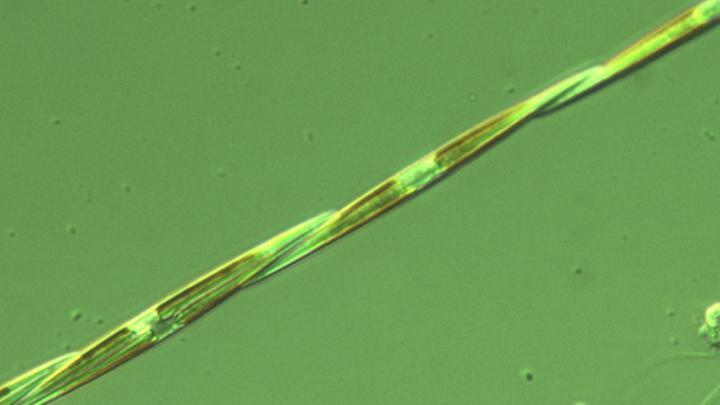Toxic 'marine snow' can sink quickly, persist at ocean depths

Chain-forming Pseudo-nitzschia cells. Credit: Astrid Schnetzer
When algae cells run out of nutrients and start to die, they clump together and sink as marine snow. The algae and its marine snow aggregates can serve as a major food source for other forms of marine life like plankton-eating fish and shellfish. Pseudo-nitzschia is a microscopic algae that occurs naturally in coastal waters, and is of particular concern due to its production of the neurotoxin domoic acid.
When domoic acid-containing Pseudo-nitzschia enter the food chain, humans can accidentally consume it via shellfish. This type of shellfish poisoning, known as amnesic shellfish poisoning, can cause neurological and gastrointestinal symptoms ranging from short-term memory loss to – in rare cases – death.
Astrid Schnetzer, associate professor of marine, earth and atmospheric sciences at NC State, wanted to know how domoic acid gets transported to depth via marine snow after a toxic algal bloom and how long it may persist. In a previous study she showed that marine snow can reach depths of several hundred meters within a few days, which contradicted previous theories suggesting that it might dissipate and dissolve long before reaching the ocean floor.
“Recent large toxic blooms off of the California coast and the attendant damage to local shellfish and the shellfish economy underscore the importance of understanding how long the marine snow remains toxic, how deep it can go and how long marine organisms are exposed to the toxin,” Schnetzer says. “The fact that high levels of domoic acid can be found in marine life months after a bloom demonstrate the need for deciphering the mechanisms by which domoic acid reaches the seafloor.”
Schnetzer and colleagues created their own toxic algal bloom in the lab using P. australis algae, one of the most toxic Pseudo-nitzschia species and one that blooms along the U.S. West Coast. They found that after two weeks, toxic marine snow from this algae could sink at rates of over 100 meters per day. Domoic acid did not dissipate appreciably during the sinking period, retaining up to 80 percent of its original toxicity.
“This study confirms that marine snow is a major vector in terms of getting domoic acid to depth,” Schnetzer says. “Our future work will focus on the ways in which smaller organisms that feed on marine snow may be affected by the toxicity, and how that in turn can affect the larger food web.”
The research appears in Harmful Algae. The work was funded by National Science Foundation grants 1459406 and 0850425 and North Carolina Sea Grant NA10OAR1040080. Schnetzer is corresponding author. NC State's Christopher Osburn, NC State and University of North Carolina at Chapel Hill's Robert Lampe, UNC-Chapel Hill's Adrian Marchetti, University of South Carolina's Claudia Benitez-Nelson and University of Southern California Los Angeles' Avery Tatters contributed to the work.
###
Note to editors: An abstract of the work follows.
“Marine snow formation by the toxin-producing diatom, Pseudo-nitzschia australis“
DOI: 10.1016/j.hal.2016.11.008
Authors: Astrid Schnetzer, Robert Lampe, Chris Osburn, NC State University; Adrian Marchetti and Robert Lampe, UNC-Chapel Hill; Claudia Benitez-Nelson, University of South Carolina; Avery Tatters, UCLA
Published: Harmful Algae
Abstract: The formation of marine snow (MS) by the toxic diatom Pseudo-nitschia australis was simulated using a roller table experiment. Concentrations of particulate and dissolved domoic acid (pDA and dDA) differed significantly among exponential phase and MS formation under simulated near surface conditions (16ºC/ 12:12-dark:light cycle) and also differed compared to subsequent particle decomposition at 4ºC in the dark, mimicking conditions in deeper waters. Particulate DA was first detected at the onset of exponential growth, reached maximum levels associated with MS aggregates (1.21 ± 0.24 ng mL-1) and declined at an average loss rate of ~1.2% pDA day-1 during particle decomposition. Dissolved DA concentrations increased throughout the experiment and reached a maximum of ~20 ng mL-1 at the final time point on day 88. The succession by P. australis from active growth to aggregation resulted in toxic MS and based on DA loading of particles and known in situ sinking speeds, a significant amount of toxin could have easily reached the deeper ocean or seafloor. MS formation was further associated with significant dDA build up at a ratio of pDA : dDA : cumulative dDA of approximately 1:10:100. Overall, this study confirms MS functions as a major vector for toxin flux to depth, that Pseudo-nitzschia-derived aggregates should be considered 'toxic snow' for MS-associated organisms, and that effects of MS toxicity on interactions with aggregate-associated microbes and zooplankton consumers warrant further consideration.
Media Contact
All latest news from the category: Earth Sciences
Earth Sciences (also referred to as Geosciences), which deals with basic issues surrounding our planet, plays a vital role in the area of energy and raw materials supply.
Earth Sciences comprises subjects such as geology, geography, geological informatics, paleontology, mineralogy, petrography, crystallography, geophysics, geodesy, glaciology, cartography, photogrammetry, meteorology and seismology, early-warning systems, earthquake research and polar research.
Newest articles

Pinpointing hydrogen isotopes in titanium hydride nanofilms
Although it is the smallest and lightest atom, hydrogen can have a big impact by infiltrating other materials and affecting their properties, such as superconductivity and metal-insulator-transitions. Now, researchers from…

A new way of entangling light and sound
For a wide variety of emerging quantum technologies, such as secure quantum communications and quantum computing, quantum entanglement is a prerequisite. Scientists at the Max-Planck-Institute for the Science of Light…

Telescope for NASA’s Roman Mission complete, delivered to Goddard
NASA’s Nancy Grace Roman Space Telescope is one giant step closer to unlocking the mysteries of the universe. The mission has now received its final major delivery: the Optical Telescope…



